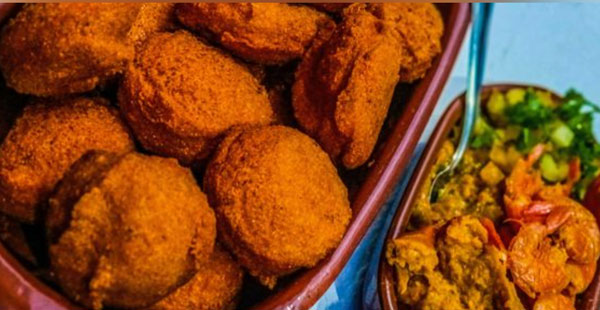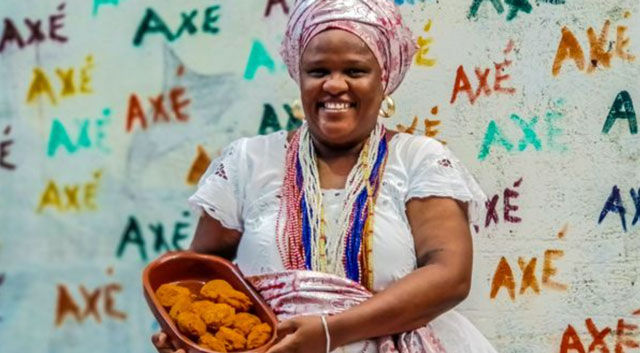
Near the vibrant city of Salvador, Ivana Muzenza makes tasty golden brown fritters from a recipe that dates back to the 19th century. The meal serves as a culinary connection to the West African roots of a unique community of Brazilian women.
SPECIAL REPORT | BIRD AGENCY | Lively conversation blends with the rhythmic sizzle of hot oil in Itapuã, a neighbourhood near the coastal city of Salvador in Bahia State, northern Brazil.
The golden brown fritters Ivana Muzenza makes at her stall, known locally as Acarajé, represent more than a tasty snack.
Muzenza is a “Baiana”, a Portuguese word that describes an exclusive community of Bahian women who sell street food while dressed in traditional attire; typically a white flowing lace dress, beaded necklaces, and jewellery, with colourful headscarves.
Muzenza’s great-great-grandmother arrived in the region towards the end of the Transatlantic Slave Trade. She became a “Ganhadeira de Acarajé”, a group of mostly enslaved African women who would walk the streets selling the delicacy. They would save up any extra money they made on top of their owners’ profit, to buy their own or a family member’s freedom.
Between the 16th and the 19th centuries, over five million Africans – mostly from West and Central Africa – were transported to Brazil. Salvador was the main port of entry, and most of them were forced to work in the Bahia region.
Salvador is now home to about 2.9 million people, according to UNESCO. Some diaspora experts classify it as the city with the largest population of people of African descent outside Africa. Its dynamic and vibrant culture is a major draw for an estimated 2.3 million visitors annually. Bahia’s historical links to Africa are evident in Bahia’s customs, music (like capoeira and samba), religion, and cuisine.
The earliest records indicate that Acarajé first appeared in the region in the 1900s.
“My great-great-grandmother was a slave, but after the ‘Free Womb Law’ was passed in 1871, the children of slaves were free, or ‘freedom babies’. She died over a century ago. My great-grandmother also lived past 100 years. I was 22 when she passed, so I had enough time with her. She taught me how to make Acarajé.”
Cultural historians say the dish originated from the Yoruba people of West Africa. It’s called Akara in southwest Nigeria today and is also eaten in Togo, Ghana, Benin, Burkina Faso, Gambia, Sierra Leone, and Mali. While a paste made from ground black-eyed beans is the common ingredient in each region, the seasoning and garnishes are unique.
In Brazil, Acarajé is also used in sacred rituals by practitioners of the Jejé or vodum branch of the Candomblé religion, which is described as a blend of West African traditions, particularly Yoruba, Bantu, and Gbe, with influences from Roman Catholicism and indigenous Brazilian beliefs.
Muzenza closely follows the recipe passed down from the family’s first Ganhadeira de Acarajé for five generations. She mixes salt and chopped onions into her bean dough, deftly moulds it into balls and then drops them into a pan of piping hot palm oil. Once the fritters are fried and cooled, she splits each to add fillings like prawns, vegetables, and hot pepper sauce.
The difference now is that Muzenza doesn’t walk the streets – she cooks and serves at Tabuleiro Cinco Acarajé, her own stall.

“Our women got permission from the Orixas – our traditional Afro-Brazilian gods – to sell Acarajé on their trays to gain their freedom. Today, we live in the city, and everyone has the freedom to sell Acarajé and support their families. It’s the main street food, a food that signifies our resistance, that’s the difference from how it’s being made and sold in Africa.”
Paulo de Jesus is an Adjunct Professor at the Federal University of Recôncavo da Bahia (UFRB) and specialises in Brazilian history.
“Many slaves were forced into trade when their owners noticed that they had entrepreneurial skills. We can attribute the vibrancy of our street markets today to those women. They also contributed to Salvador’s development. Back then there were no vehicles or mechanisation, so the men were manual labourers, and the women supplied meals at their work sites all over the city. It’s why Brazil’s street food industry is so rich today, it’s the result of the women’s ‘entrepreneurial DNA,'” de Jesus noted.
Baianas like Muzenza charge US$15-25 per serving of Acarajé, depending on the toppings selected. They earn approximately BRL$1412 per month, which is about US$270. They usually make more during the summer, when tourist numbers rise.
Baianas de Acarajé leaders complain that inflation, urban planning restrictions, competition from fast-food chains, and a lack of cultural appropriation laws are threatening their livelihood.
Muzenza recalled how her mother and grandmother initially discouraged her from joining the family business.
“Why can’t this be treated as a formal profession? It’s a lot of hard work. But today, you can just buy ready-made dough. There’s heritage and a sacred element to consider. Unfortunately, people don’t understand that Acarajé is an ancestral food and business that should be preserved. It’s difficult to have a dialogue with those who view it as any other food, which prevents us from entering the commercial market and getting a fair price for our product.”
Another challenge is the scarcity of verified data and statistics about the specific economic contribution of Baianas de Acarajé.
The National Confederation of Brazilian Trade 2022 Survey estimates that street vendors generate approximately US$10.2 billion annually. According to the International Labour Organization’s (ILO) 2020 Report, over 38% of Brazilian workers were estimated to be in informal employment in 2018.
de Jesus advocates for policymakers to support Baianas given their social and economic significance. He added that the gaps Muzenza and others experience in academic, financial, and legislative inclusion are the result of historical marginalisation.
“The entrepreneurial DNA is eroded because a dangerous perception persists that it doesn’t need to be developed. There should be investment in this community and their cultural heritage. A Baiana de Acarajé is not alone; she holds a wider community together. She carries ancestral knowledge,” de Jesus added.
The Baianas de Acarajé have made several gains in their fight for official recognition. In 2002, a municipal law was passed designating Acarajé as part of Salvador’s cultural heritage. In 2004, The National Historical and Artistic Heritage Institute (IPHAN) added the techniques for preparing Acarajé in Bahia to its curation of Brazil’s history. November 25th is set aside as National Acarajé Day.
However, Muzenza argues that more needs to be done.
“It’s still not enough for us to get real value from our culture. Acarajé is being served in restaurants in Salvador that attempt to create a ‘gourmet’ version for tourists, detached from its true origins. While the government recognises the legitimacy of our traditions, it doesn’t provide the level of support we need to compete with those establishments,” she said.
Some Baianas say the daily ritual of getting dressed and cooking renews their strength and sense of purpose.
Muzenza is fiercely protective of a legacy that endured the horrors of forced migration and numerous attempts to suppress its significance.
Her Acarajé isn’t just meant to be a delicious meal. Muzenza often watches intently as customers devour a fresh batch because their enjoyment and appreciation pay homage to the long line of proud, resilient Baianas who paved her way.
*****
Iris Pacheco, bird story agency
 The Independent Uganda: You get the Truth we Pay the Price
The Independent Uganda: You get the Truth we Pay the Price



